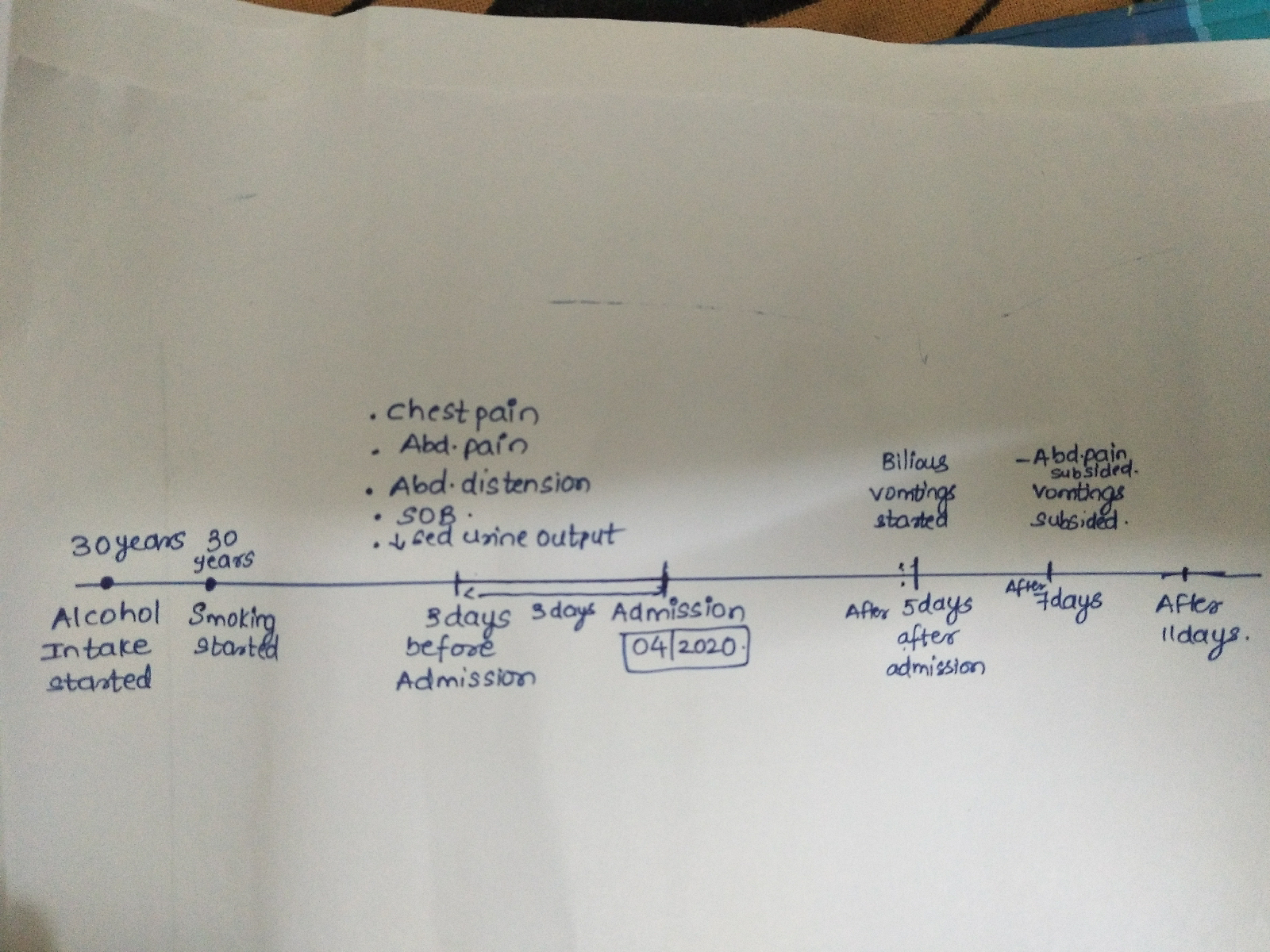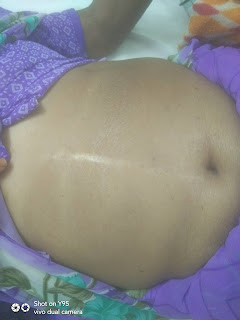Exam 16/11/2020
Question 1) pain in the epigastric region differentials
Inferior wall MI(normal ecg and echo)
Acute pancreatitis(radiation to the back)-usg finding and elevated serum amylase level
Perforated peptic ulcer
Causes of acute pancreatitis-harrison pg no 2348
Gall stones :https://gi.org/topics/gallstone-pancreatitis/
This occurs at the level of the sphincter of Oddi, a round muscle located at the opening of the bile duct into the small intestine. If a stone from the gallbladder should travel down the common bile duct and get stuck at the sphincter, it blocks outflow of all material from the liver and pancreas. This results in inflammation of the pancreas that can be quite severe.
2)sob- acidosis due to renal failure
? Ards secondary to sepsis/pancreatitis
Pleural effusion due to acute pancreatitis
3)decreased urine output-pre renal Aki secondary to volume loss(oliguric)
3rd space loss due to pancreatitis
Sepsis induced aki
4) abdominal distention with constipation and nausea
Secondary to paralytic ileus
2) pharmacological interventions
https://link.springer.com/article/10.1007/s00534-005-1050-8
1)fluid replacement
Increased vascular permeability in acute pancreatitis causes the loss of intravenous fluid and reduces plasma volume. In severe cases, in patients with massive ascites, pleural effusion, and retroperitoneal and mesenteric edema, circulating plasma volume decreases markedly. Hypovolemia may lead to shock and acute renal failure, and, because hypovolemic shock may impair the pancreatic microcirculation and promote pancreatic ischemia and necrosis, restoration and maintenance of plasma volume is crucial in severe acute pancreatitis.
2) antibiotics
On the other hand, a placebo-controlled, double-blind trial of ciprofloxacin + metronidazole in patients with predicted severe acute pancreatitis showed that prophylactic administration of these antibiotics did not prevent pancreatic infection (Level 1b).
3)analgesics
4) nebulization in view of b/l wheeze secondary to ?copd
5)diuretics for decreased urine output due to renal failure
Non pharmacological interventions
1)nill per mouth
https://pubmed.ncbi.nlm.nih.gov/27107634/
2)ryles tube catheterisation
3)oxygenation
Question 2:(55M)
https://aakansharaj.blogspot.com/2020/11/55-year-old-male-with-anemia.html?m=1
1)bone marrow and bones
2)kidneys
https://www.ncbi.nlm.nih.gov/pmc/articles/PMC3205153/
The pathophysiology of renal failure in multiple myeloma is often multifactorial but is mostly due to the high excretion of immunoglobulin free light chains. When the light chains combine with Tamm-Horsfall proteins, they form obstructing casts (5). Chemotherapy should therefore be initiated rapidly to decrease light chain production. Intravenous fluids can be given to treat volume depletion, hypercalcemia, or hyperuricemia.
3)lungs(infection-incrsead susceptibility)
https://www.cancer.org/cancer/multiple-myeloma/causes-risks-prevention/what-causes.html
Researchers have found that patients with plasma cell tumors have important abnormalities in other bone marrow cells and that these abnormalities may also cause excess plasma cell growth. Certain cells in the bone marrow called dendritic cells release a hormone called interleukin-6 (IL-6), which stimulates normal plasma cells to grow. Excessive production of IL-6 by these cells appears to be an important factor in development of plasma cell tumors.
A) pharmacological interventions
Antibiotics (?aytpical pneumonia-azithromycin)
However, the infections encountered in patients with MM include: (1) bacterial infections, predominantly involving respiratory and urinary tract, caused by Streptococcus pneumonia, Staphylococcus aureus, Haemophilus influenzae, Klebsiella pneumonia, Escherichia coli, Pseudomonas aeruginosa, and Enterobacteriaceae; (2) viral infections caused by herpes simplex virus (HSV), VZV, and cytomegalovirus (CMV); (3) fungal infections caused by Candida species and Aspergillus species; and (4) Pneumocystis jiroveci pneumonia
Blood transfusion
B)non pharmacological
Pleural fluid analysis
Imaging -xray skull, hrct chest
Serum electrophoresis,sputum culture
Question 3)
http://nithishaavula.blogspot.com/2020/11/51-yr-old-male-with-hfref.html?m=1
1)pedal edema with abdominal distention with sob suggestive of right heart failure or renal failure
B)etilogy of rt heart failure
https://www.ncbi.nlm.nih.gov/books/NBK459381/
- Primary pulmonary arterial hypertension (PAH) and secondary pulmonary hypertension (PH) as seen in chronic-obstructive pulmonary disease (COPD) or pulmonary fibrosis)
- Congenital heart disease (pulmonic stenosis, right ventricular outflow tract obstruction, or a systemic RV).
- Valvular insufficiency (tricuspid or pulmonic)
- Congenital heart disease with a shunt (atrial septal defect (ASD) or anomalous pulmonary venous return (APVR)).
- RV ischemia or infarct
- Infiltrative diseases such as amyloidosis or sarcoidosis
- Arrhythmogenic right ventricular dysplasia (ARVD)
- Cardiomyopathy
- Microvascular disease.
- Constrictive pericarditis
- Tricuspid stenosis
- Systemic vasodilatory shock
- Cardiac tamponade
- Superior vena cava syndrome
- Hypovolemia.
2 )Pharmacological interventions
https://heart.bmj.com/content/104/5/407(meta analysis with each class of drugs)
Preload reducers
Diuretics
Afterload reducers-ace inhibitors
Rate controlling agents-beta blockers
Antiepileptics for known case of epilepsy
Insulin for glycemic control in diabetes.
Non pharmacological interventions
Salt and fluid restriction
https://pubmed.ncbi.nlm.nih.gov/23787719/
Individualized salt and fluid restriction can improve signs and symptoms of CHF with no negative effects on thirst, appetite, or QoL in patients with moderate to severe CHF and previous signs of fluid retention.
Question 4
1)heart(rt and left)
https://www.ncbi.nlm.nih.gov/pmc/articles/PMC5851725/
Wet beriberi is one of the clinical syndromes associated with thiamine deficiency. Thiamine, in its phosphorylated form thiamine pyrophosphate (TPP), is the precursor for the cofactor of both pyruvate dehydrogenase and alpha-ketoglutarate dehydrogenase, which are both key enzymes of the Krebs cycle. The Krebs cycle is an essential part of aerobic glucose metabolism. A decrease in the activity of these 2 enzymes due to thiamine deficiency may lead to the tissue accumulation of pyruvate and lactate.[1] Moreover, the accumulation of pyruvate and lactate decreases peripheral resistance and increases venous blood flow, increasing the cardiac preload. Increased preload and myocardial dysfunction ultimately leads to congestive heart failure.
https://www.medindia.net/patients/patientinfo/beriberi-disease.htm
Other conditions cause beriberi include:
- Excessive alcohol usage, which results in inadequate intake in the diet as well as prevents the body from absorbing and storing vitamin B1.
- Genetic beriberi, which is an inherited condition where people lose the ability to absorb thiamine from foods. Symptoms usually present during adulthood.
- Pregnancy; pregnant women often present with vitamin B1 deficiency. Breastfeeding infants can suffer from vitamin B1 deficiency if the mother is deficient.
- People with endocrine disorders like hyperthyroidism who require extra vitamin B1.
- Chronic liver disease, which prevents the body from absorbing sufficient vitamin B1.
- Kidney dialysis, which leads to a loss of vitamin B1.
- A prolonged bout of diarrhea, which also leads to a loss of vitamin B1.
1) pharmacological interventions
Diuretics
Thiamine
2)non pharmacological interventions
Salt and fluid restriction





Comments
Post a Comment